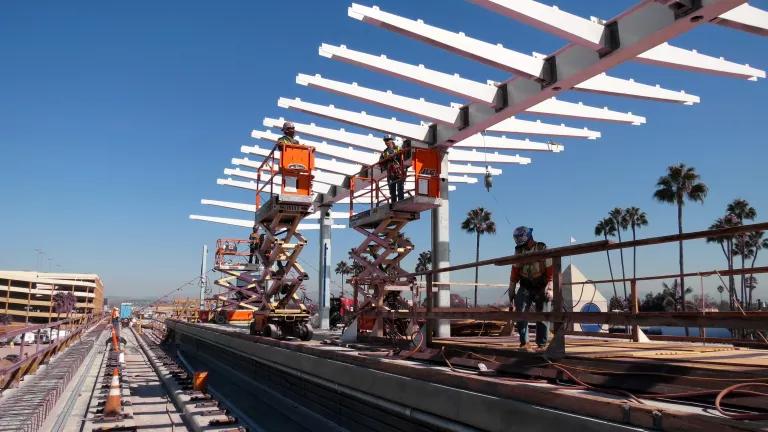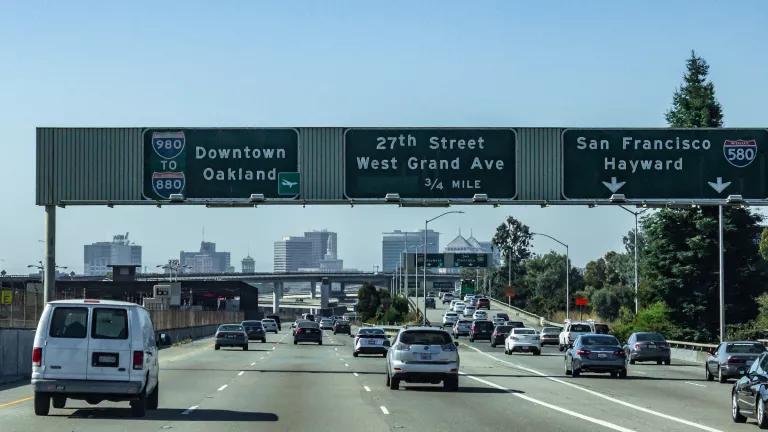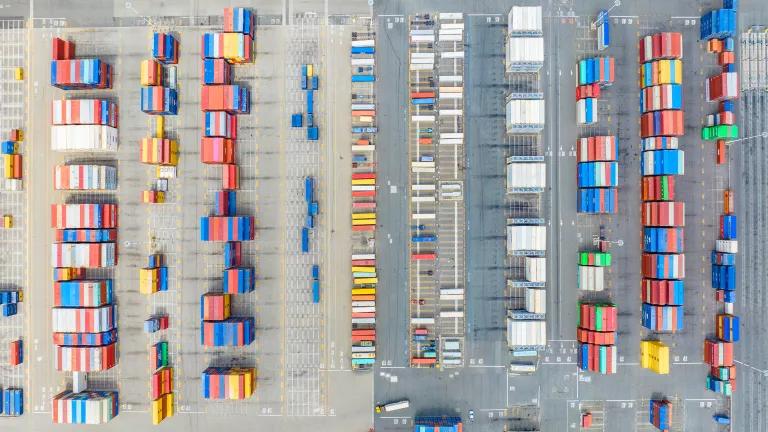California Is Short-Changing Climate-Friendly Mobility
A new NRDC report finds that California only allocates 18.6% of transportation funds to low-carbon mobility choices. Read the full report here.

Corcoran, California received a grant of nearly $2 million from the Active Transportation Program for Safe Routes to School projects.
California stands at a crossroads for its transportation system. One road leads down a path filled with ever-wider roads jammed with polluting vehicles that push Californians further from jobs, schools and their neighbors. The other road takes us to abundant, clean transportation choices that support healthy, connected and affordable neighborhoods with high road jobs.
As the state presses forward with ambitious and necessary work to zero out climate-warming pollution, transportation has emerged as State’s single biggest contributor. Most of those emissions come from the cars and trucks that travel our state's roadways every day.
Unfortunately, our elected and community leaders have lacked the information needed to understand if our transportation investments are enabling the polluting status quo or moving us down a better path.
A new report from NRDC released this week provides much needed insight into where our transportation dollars are flowing and charts a path forward that aligns the State's transportation investments with its climate goals.
Our analysis finds that California state agencies have only allocated 18.6% of available funds towards projects and programs that are helping curb Californians’ reliance on private automobiles by investing in projects and programs like bike lanes, sidewalks, electric buses, mass transit, regional rail systems and affordable housing.
The remaining 81.4% is allocated respectively towards maintaining (71.7%) and expanding (9.7%) the current system of roads and highways that contribute not only to climate pollution, but also unhealthy air, urban sprawl and endemic traffic fatalities. To zero out pollution from the transportation system, we need to stop expanding our roads and leverage maintenance investments to expand clean transportation options. This is an all-hands-on-deck effort that depends on fully aligning public spending with climate and clean air priorities.
Following the money in California's transportation programs
We analyzed the committed and planned investments from the following State transportation funding programs covering the years 2019 through 2027:
| Active Transportation Program (ATP) | Solutions for Congested Corridors Program (SCCP) |
| Affordable Housing and Sustainable Communities (AHSC) | State Highway Operations & Protection Program (SHOPP) |
| Local Partnership Program (LPP) | State Transportation Improvement Program (STIP) |
| Local Streets and Roads Program (LSRP) | Trade Corridor Enhancement Program (TCEP) |
| Low-Carbon Transit Operations Program (LCTOP) | Transit and Intercity Rail Capital Program (TIRCP) |
We found that many programs like the Affordable Housing and Sustainable Communities (AHSC) program, the Low-Carbon Transit Operations Program (LCTOP), the Transit and Intercity Rail Capital Program (TIRCP), and the Active Transportation Program (ATP) were very-well aligned with the State’s efforts to reduce VMT and address climate change. No funding in these programs went to projects that increase VMT.
In contrast, the Trade Corridor Enhancement Program (TCEP 2021) and the Solutions for Congested Corridors Program (SCCP 2020) allocated a majority of their funding to highway expansions that increase VMT in the years we analyzed.
The state’s largest funding program, State Highway Operations & Protection Program (SHOPP) accounts for over $16 billion in investment in maintaining the state's roads and highways. But only a little over $1B, or seven percent of SHOPP funding, has been successfully leveraged to implement projects that would substantially reduce VMT and deliver benefits to Californians walking, biking or taking public transit.
How we can get on the right track
Our report concludes with several recommendations that will help the state better align its investment decisions with its climate goals.
- Discontinue funding for projects that increase highway capacity and thus increase VMT and greenhouse gas emissions. Projects should be rescoped to achieve project goals in ways that align with the State's climate goals.
- Revise projects that have no impact on VMT to incorporate greater benefits to people walking, biking and taking public transit. Caltrans’ recent Complete Streets policy is a good start and should be implemented at scale on projects that Caltrans is involved in, as well as local and regional projects.
- Build a better pipeline of VMT-reducing projects so that money can flow to shovel-ready and shovel-worthy projects.
- Create more transparent process for tracking and reporting data on projects so decision-makers and the public can better understand the overall impacts of our investment choices.
More driving = more traffic and more pollution
Understanding how and where California invests in transportation isn’t simple. Indeed, its hard to see the forest for the trees when decisions about how to invest the state’s transportation dollars are made across multiple years and a nearly a dozen transportation programs, i.e. pots of funding with special rules for how the money has to be spent.
So NRDC began combing through various state websites and project lists comprising thousands of budget line-items corresponding to individual projects to count where the dollars were going and what the likely impact of those investments would be on a key metric known as “vehicle-miles traveled” (VMT).
Why VMT? The California Air Resources Board’s latest plan for how the state will reach its climate goals requires the State to reduce per capita VMT 25% by 2030 and 30% by 2045 compared to 2019, at the same time we electrify all the vehicles on the road. Any realistic path to hitting those goals will require a major shift in investment priorities towards projects that reduce VMT, zeroing out projects that increase VMT, and leveraging road maintenance dollars to the maximum extent possible to deliver benefits to people walking, biking and taking transit.
Having compiled this list of projects, we determined if individual projects were likely to increase VMT, decrease VMT or have no impact on VMT using guidance on measuring transportation impacts developed by the Governor’s Office of Planning and Research.
Greater transparency in transportation funding can help answer other important questions like: how much of our transportation funding is going to creating transit stops and bus rapid transit routes that encourage more infill, affordable housing? We find it's less than 2% of the funding in our database.
What's next?
California has made some important progress in recent years under the umbrella of the Climate Action Plan for Transportation Infrastructure, which have moved the State’s investment portfolio in the right direction. These shifts are welcome, needed, and still insufficient to meet the scale and urgency of the climate crisis.;
This report is a stepping stone to aligning our transportation investments with solving the state's biggest challenges: addressing climate change, backstopping essential transit systems, investing in transit projects that help address the housing crisis with high-quality jobs and more.
This summer California lawmakers and Governor Newsom finalized a budget package with major implications for the State’s clean mobility options. Advocates for public transit secured a necessary but incomplete victory that delivers greater investment in California’s bus and rail systems.
With every year’s State budget and in every new program funding cycle, the State has an opportunity to more fully embrace a climate-friendly and equitable approach to funding transportation. That means investing in projects that connect communities rather than divide them, and provide clean and affordable options for all.




